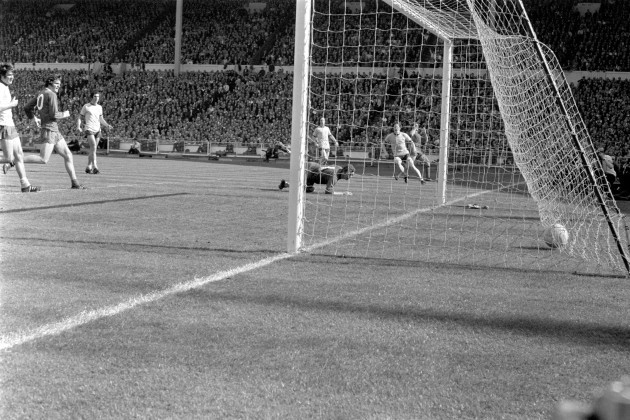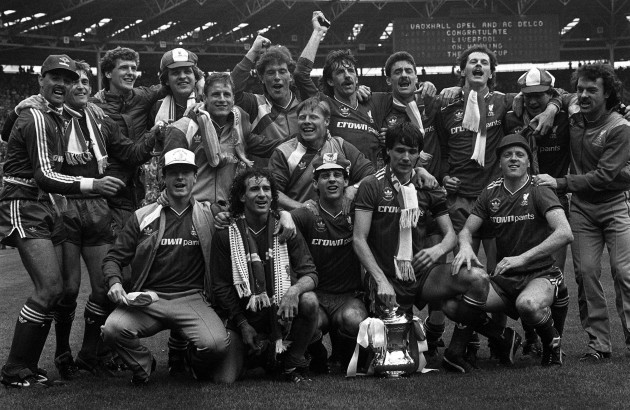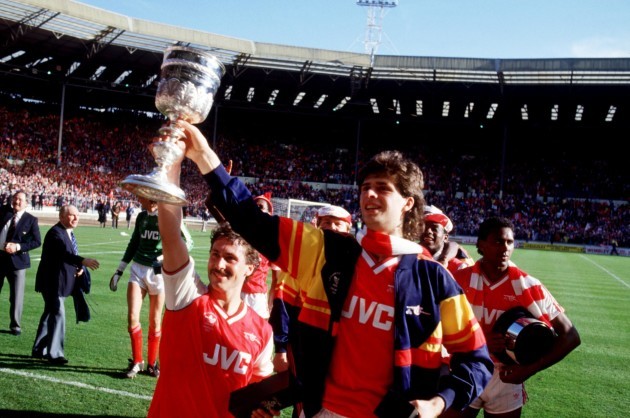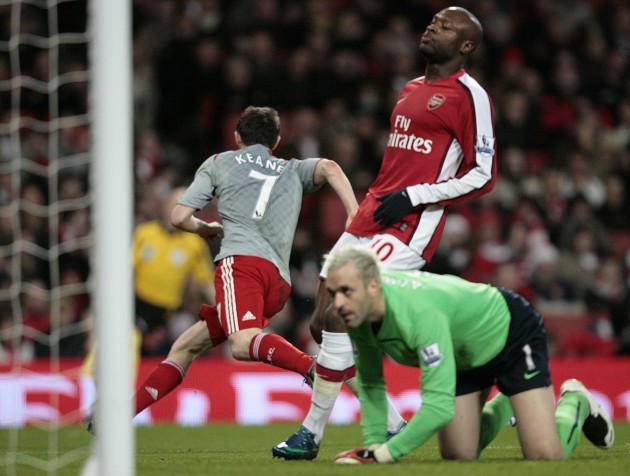IT IS AN English production with a cast drawn from all across the world. And yet if the authorities were to allow an audience into Anfield tomorrow, there is absolutely no question that an Irish presence would be felt.
You’d imagine it was always this way, especially when you consider the survey conducted by Empathy Research for An Atlas of Irish Sport and published by Cork University Press this year which highlighted how both clubs draw support from over 600,000 Irish adults in this country.
The truth is a little more complicated, though. For while Liverpool has always been considered an Irish city – highlighted by the fact it was the only constituency outside of Ireland to ever return an Irish Nationalist MP – it was initially Everton who drew the larger Irish support.
The Toffees first ever chairman was a Home Ruler educated in Dublin; they were one of the first in England to sign an Irishman – Jack Kirwan from St James Gate in 1898; and were the first English club to have a supporters’ association set up in Ireland.
“In Liverpool, Everton was the Catholic team and Liverpool the Proddy-Dog one,” said singer Cilla Black of her childhood in 1950s Liverpool. “Catholics were traditionally Everton supporters and players, Liverpool were the Protestant team,” said Tommy Smith, who went on to become a legend at Anfield. “Pop Moran (his mentor as a youth) honestly thought that being a Catholic I wouldn’t be happy at Anfield.”
Yet he was. As were thousands and thousands of Irish Liverpool fans whose affection for the club gradually grew during the ‘50s, when emigration was on the rise, even more so in the ‘60s when Shankly’s revolution had taken hold. Yet it was the arrival of colour TV and an unforgettable Cup final that had a bigger impact.
Arsenal 2-1 Liverpool, FA Cup final, Wembley, 8 May 1971
Steve Heighway, slim, astonishingly quick, the possessor of a brilliant technique and a Beatles-type hairstyle had another, particularly marketable quality to an Irish audience. He was Dublin-born.
For years, the traffic from Ireland to Liverpool had mainly ended up in one place: Goodison. From Tommy Clinton to Peter Corr, Tommy Eglington to Peter Farrell, Jimmy O’Neill to George Cummins, Dan Donovan to Mick Meagan, Everton had a distinctly Irish edge whereas Liverpool was a home-from-home for Scots, over 150 of them signing for the club since their formation.
Then came Heighway – along with colour TV. Way back then, the FA Cup was the only game shown live on people’s screens, outside of World Cups. The 1968 final was the first broadcast in colour but was a shocker, so too the ’69 decider. But 1970 – the Chelsea/Leeds battle – was different. Generations of Irish fans flocked to those tribes.
A year later, Liverpool and Arsenal set out their marketing strategy, playing a wonderful final, decided by Charlie George’s screamer – but only after Heighway had duped Bob Wilson into thinking he was about to cross, when instead he shot, scoring a brilliantly opportunistic goal. Eight months earlier he had made his debut for Ireland and here he was, surrounded by six Scots, a Northern Ireland international and 16 Englishman, the sole flier of the Irish flag on English football’s big stage.
The days of Everton remaining the city’s Irish club were about to end.
Arsenal 1-0 Liverpool, 1 May 1980, FA Cup semi-final 3rd replay
They listened to the semi-final draw in the old communal bath at Highbury. “Arsenal will play Liverpool,” the posh voice from FA headquarters announced. “That’ll do us,” said John Devine, a Dubliner, one of seven Irishmen sitting in that bath. Fellow Dubs Frank Stapleton, David O’Leary and Liam Brady were in there too, as were Northern Irish internationals Pat Rice, Sammy Nelson and Pat Jennings.
“We were Irishmen taking on the world,” says Devine. That spring, they took on Liverpool in a four-game epic in the FA Cup semis, eventually prevailing against a side who were about to win their fifth league title in eight seasons, having also won the European Cup in ’77 and ’78.
That ‘Irish’ team based out of a north London address had a profound influence on a generation of supporters here, who saw the side break-up almost as soon as it was formed, Brady leaving for Juventus that summer, Stapleton going to Old Trafford a year later, Rice getting shipped out, Nelson and Devine lasting just a few years more.
Significantly, for the final game of the four-match Cup saga, Liverpool didn’t have one Irish player in their starting X1. That was about to change in the following decade.
Arsenal 0-2 Liverpool, Highbury, 10 September 1983
Three years after losing to Arsenal in the FA Cup, Liverpool had become the dominant team in the rivalry and indeed remained the dominant team in English football. Yet they weren’t exactly English – their goalkeeper coming from Zimbabwe, their spine of the team – Hansen, Souness, Dalglish from Scotland, their thin, deadly finisher from Wales. And then there was the Irish contingent: Ronnie Whelan, Mark Lawrenson, Mick Robinson.
Later that decade, Jim Beglin, Steve Staunton, John Aldridge and Ray Houghton would be added to the mix. “England’s lower leagues provided a pathway for Liverpool back then,” Phil Thompson, the former Liverpool captain and coach, said. “Historically, Liverpool’s success was built on smart recruitment from clubs like Scunthorpe [where Kevin Keegan and Ray Clemence were signed from] or Brighton [where Ireland stars Robinson and Lawrenson came from].
“Sure, it’s different now. The club increasingly shops abroad but that Irish presence in the dressing room is missed. Liverpool and Ireland always had that bond. Men like Ronnie Whelan and Lawro always had that passion and that hunger to succeed. You talk about mental strength.
All those Irish players we had then were winners, big-game players who never let you down. Look at the trophies we won in the 80s – look at the team photographs. There was always an Irishman there. What does that tell you about those men?”
Arsenal 2-1 Liverpool, 5 April 1987, Wembley, League Cup final
This was Charlie Nicholas’ day, really – but from an Irish perspective, it was also the only time Niall Quinn – then a gangly 20-year-old striker – won a major medal. David O’Leary had also hung around through a grim decade, one where the promise of the 1979/80 season had quickly disappeared.
Winning the title on the final day of the 88/89 season was the definitive image of that era from an Arsenal perspective – but to some of us, the League Cup final win in ’87 was surprisingly special, given that O’Leary was joined on the pitch by another Irishman, given that it was the first trophy many youthful Irish Gunners had watched them win.
Victory led to further glory under George Graham: two league titles, the FA Cup, a second League Cup win in ’93 and the Cup Winners’ Cup the following year. But ’87 was Quinn’s year. “That full season, the shirt was mine,” Quinn said. “No 9 for Arsenal, for a 20-year-old – that was huge.
“We’d come through a tough semi-final against Spurs – George literally pinned us up, man by man, against the wall and said, ‘This is Arsenal against Spurs, you’re fighting for history here, and these f*****s are already selling tickets for the final. What are you going to do about it?’ “The adrenaline rush was like all the things you read about in hurling dressing rooms, it was mad stuff. We ran out, played them off the park, and got a replay out of it, which we won, after being a goal down. Winning the final, it was one of the highlights of my career.”
Liverpool 0-2 Arsenal, 26 May 1989, Anfield
For different reasons, that year resulted in so many Irish fans flocking to both clubs. For Arsenal supporters, the thrill of seeing their team win the title in the final minute of the season was unforgettable, putting the Sergio Aguero moment in the ha’penny place.
But infinitely more important than a football match was what happened a month earlier at Hillsborough, the shocking loss of 96 lives followed by the terrible injustice of the official cover-up.
Looking back now from a vantage point of 31 years, you can see why that year was such a definitive one. Liverpool would win the league the following year, then endure their 30-year wait for title No19 and yet their support in Ireland regenerated, people here able to easily identify with what the club stood for.
As for Arsenal’s Irish fans, well they weren’t ever going to forget the sight of Thomas charging through the midfield, were they?
Arsenal 0-1 Liverpool, 12 April 1995, Highbury
A forgettable game in many respects except that this was the last time an Irish player started a Premier League game against Liverpool. Eddie McGoldrick would soon move to Manchester City – a pathway many better players would also take in the following decades as the footballing landscape changed.
Gradually Irish players became less of a presence in all the big six – Arsenal the first of them to become an Irish-free zone but far from the only one.
As for Liverpool, Whelan got old, Staunton and Houghton got sold. It took Roy Evans to bring a new broom of Irishmen back into the club – Mark Kennedy, Phil Babb and Jason McAteer. Steve Finnan then kept the home fires burning and made it all the way to the winners’ podium in Istanbul.
Arsenal, meanwhile, gradually acquired more of a French influence than an Irish one – although seven of the English players who featured in this meaningless 1-1 draw in April 1995 went on to win the double under Arsene Wenger three years later.
Tellingly, though, Wenger never signed an Irish player for the first-team during his long tenure at the club, although he did give a number of debuts to Irish youngsters who came through the club’s academy, including Graham Barrett, Anthony Stokes and Brian McGovern.
Arsenal 1-1 Liverpool, 21 December 2008, Emirates Stadium
This game was the last time an Irishman scored a Premier League goal for Liverpool in this particular rivalry. It also happened to be some goal, easily Robbie Keane’s best moment in a Liverpool shirt.
Signed for €22m just six months earlier, he went into that game with just four goals to his name and embarrassing headlines such as one in that week’s edition of Kop magazine: “Will Robbie Keane Ever Come Good?”
The answer came that day when he scored a superb half-volley but it didn’t save his Liverpool career. “Dear old Robbie Keane is about as wanted this Christmas as a diamond-patterned jumper from your aunt,” wrote The Sun.
Speculation about his future remained rife. In an interview with Today FM Mark Lawrenson revealed he was told by Liverpool captain Gerrard that Keane “could be moved on” the following month.
Rafa Benitez denied it but a few weeks later when it was put to Benitez that his lack of faith in Keane was puzzling given he had spent €22m on the player, he retorted. “The club. The club spent £22m.”
Two weeks later, Keane was sold back to Spurs. Neither Liverpool nor Arsenal have had an Irishman feature regularly in their first-team since.





